Edelstein-Keshet L. Mathematical Models in Biology
Подождите немного. Документ загружается.

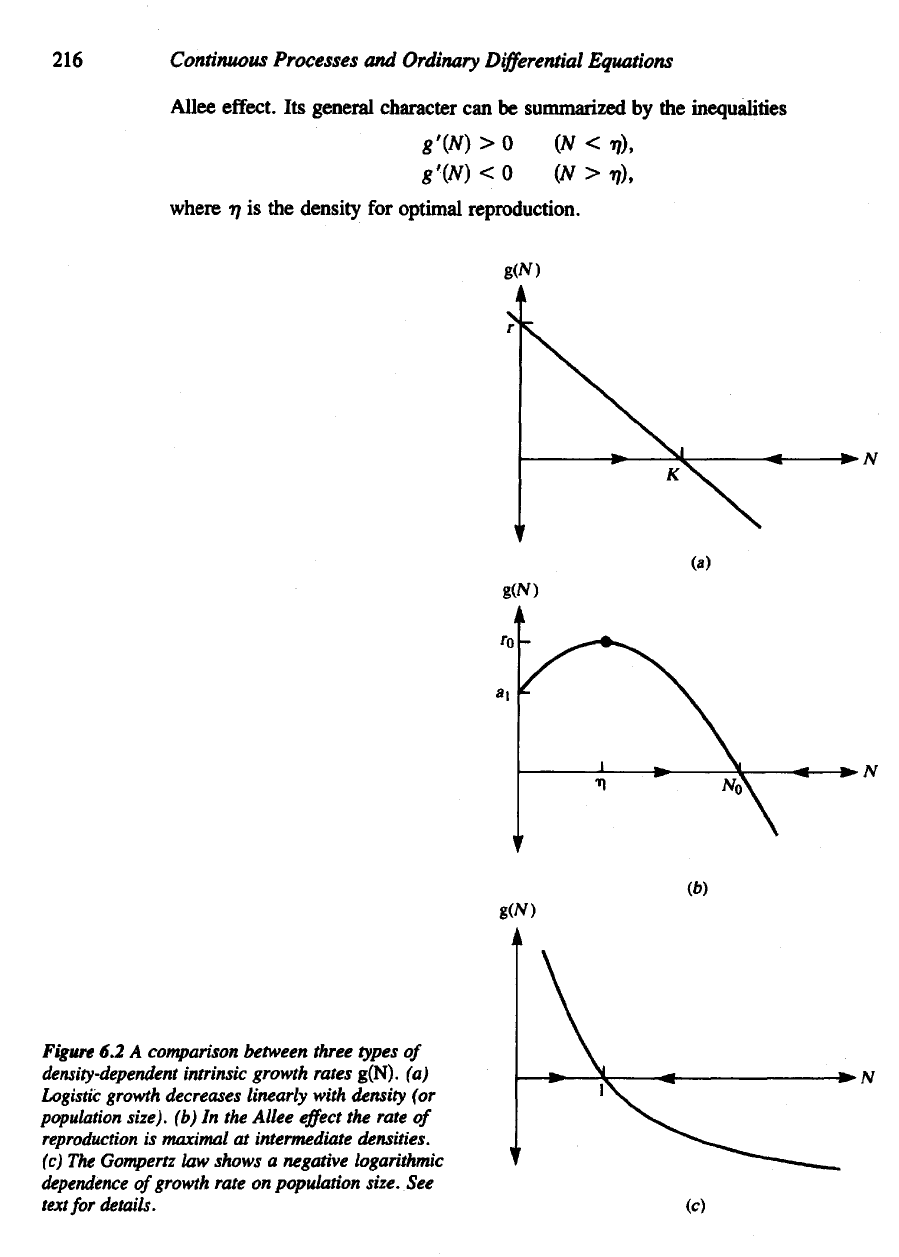
216
Continuous
Processes
and
Ordinary
Differential
Equations
Alice
effect.
Its
general character
can be
summarized
by the
inequalities
Figure
6.2 A
comparison between three
types
of
density-dependent
intrinsic growth rates
g(N).
(a)
Logistic
growth decreases linearly with density
(or
population
size),
(b) In the
Allee
effect
the
rate
of
reproduction
is
maximal
at
intermediate densities,
(c)
The
Gompertz
law
shows
a
negative logarithmic
dependence
of
growth rate
on
population
size.
See
text
for
details.
where
17 is the
density
for
optimal reproduction.
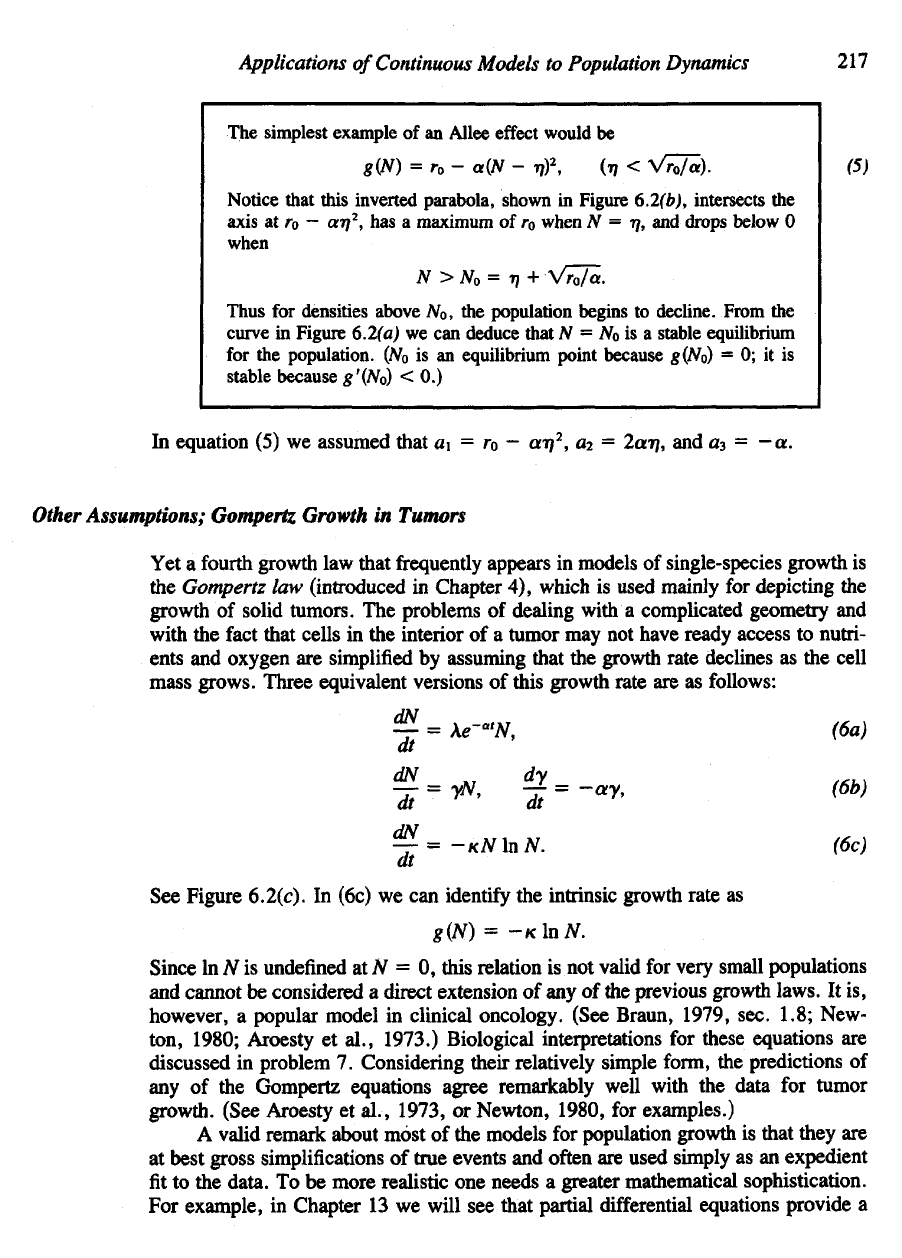
Applications
of
Continuous
Models
to
Population
Dynamics
217
In
equation
(5) we
assumed that
a\ = r
0
-
ar\
2
,
a-i
=
2arj,
and «
3
= -a.
Other
Assumptions;
Gompertz
Growth
in
Tumors
Yet a
fourth
growth
law
that frequently appears
in
models
of
single-species growth
is
the
Gompertz
law
(introduced
in
Chapter
4),
which
is
used mainly
for
depicting
the
growth
of
solid tumors.
The
problems
of
dealing with
a
complicated geometry
and
with
the
fact
that
cells
in the
interior
of a
tumor
may not
have ready access
to
nutri-
ents
and
oxygen
are
simplified
by
assuming that
the
growth rate declines
as the
cell
mass grows. Three equivalent versions
of
this growth rate
are as
follows:
Since
In N is
undefined
at
AT
= 0,
this relation
is not
valid
for
very small populations
and
cannot
be
considered
a
direct
extension
of any of the
previous growth laws.
It is,
however,
a
popular model
in
clinical oncology. (See Braun, 1979, sec. 1.8; New-
ton, 1980; Aroesty
et
al.,
1973.)
Biological
interpretations
for
these equations
are
discussed
in
problem
7.
Considering their relatively simple
form,
the
predictions
of
any
of the
Gompertz equations agree remarkably well with
the
data
for
tumor
growth. (See Aroesty
et
al., 1973,
or
Newton, 1980,
for
examples.)
A
valid remark about most
of the
models
for
population growth
is
that they
are
at
best gross simplifications
of
true events
and
often
are
used simply
as an
expedient
fit to the
data.
To be
more realistic
one
needs
a
greater mathematical sophistication.
For
example,
in
Chapter
13 we
will
see
that partial differential equations provide
a
See
Figure
6.2(c).
In
(6c)
we can
identify
the
intrinsic growth rate
as
The
simplest example
of an
Allee
effect
would
be
Notice that this inverted parabola, shown
in
Figure 6.2(b),
intersects
the
axis
at r
0
—
ar)
2
,
has a
maximum
of r
0
when
N = rj
t
and
drops below
0
when
Thus
for
densities
above
Af
0
,
the
population begins
to
decline. From
the
curve
in
Figure
6.2(a)
we can
deduce that
N =
M>
is a
stable equilibrium
for
the
population.
(N
0
is an
equilibrium point
because
g(M>)
= 0; it is
stable because g'(N
0
)
< 0.)
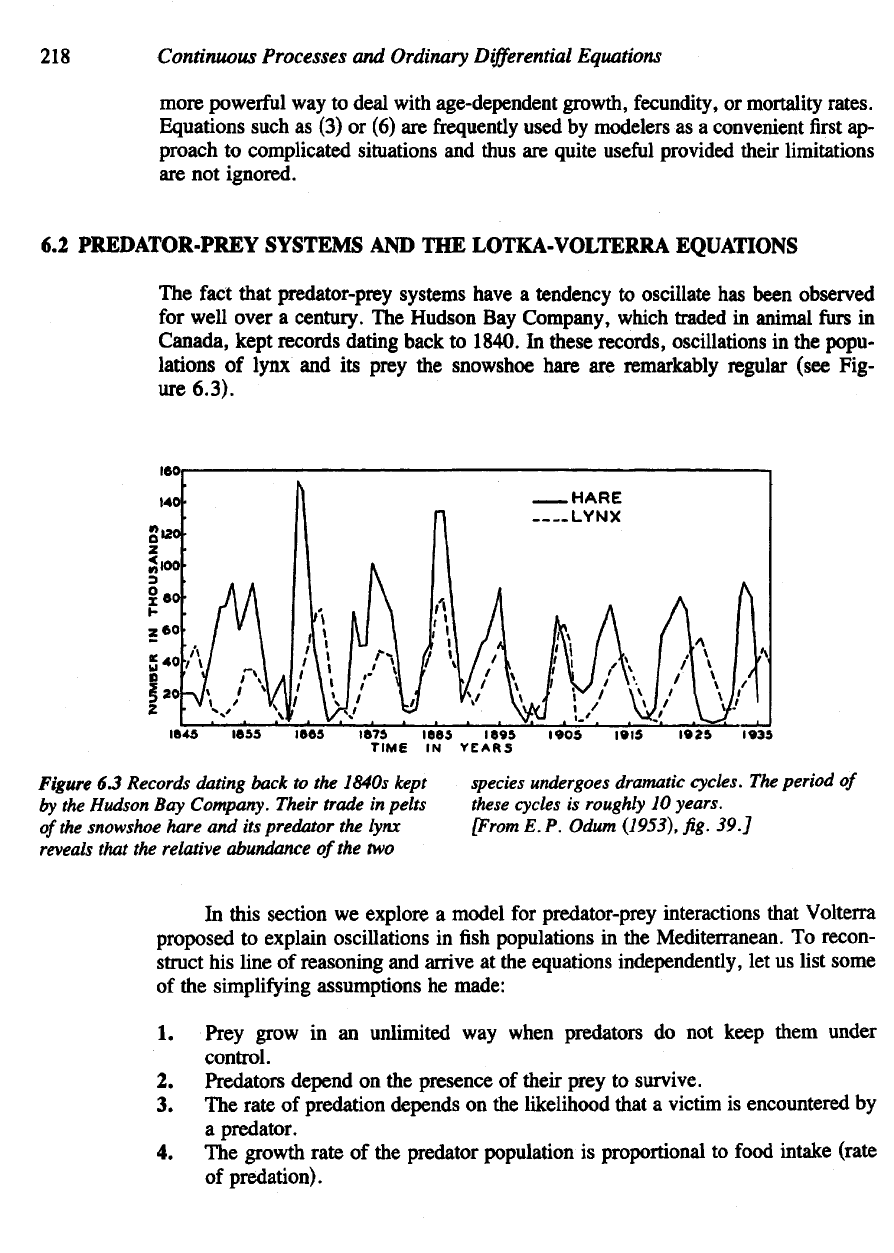
218
Continuous Processes
and
Ordinary
Differential
Equations
more powerful
way to
deal
with
age-dependent growth,
fecundity,
or
mortality rates.
Equations such
as (3) or (6) are
frequently
used
by
modelers
as a
convenient
first ap-
proach
to
complicated situations
and
thus
are
quite
useful
provided their limitations
are
not
ignored.
6.2
PREDATOR-PREY SYSTEMS
AND THE
LOTKA-VOLTERRA EQUATIONS
The
fact
that predator-prey systems have
a
tendency
to
oscillate
has
been observed
for
well over
a
century.
TTie
Hudson
Bay
Company, which traded
in
animal
furs
in
Canada, kept records dating back
to
1840.
In
these records, oscillations
in the
popu-
lations
of
lynx
and its
prey
the
snowshoe hare
are
remarkably regular (see Fig-
ure
6.3).
Figure
63
Records dating back
to the
1840s kept
by
the
Hudson
Bay
Company.
Their trade
in
pelts
of
the
snowshoe
hare
and its
predator
the
lynx
reveals that
the
relative
abundance
of
the two
species undergoes
dramatic
cycles.
The
period
of
these cycles
is
roughly
10
years.
[From
E. P.
Odum (1953),
fig.
39.]
In
this section
we
explore
a
model
for
predator-prey interactions that Volterra
proposed
to
explain oscillations
in fish
populations
in the
Mediterranean.
To
recon-
struct
his
line
of
reasoning
and
arrive
at the
equations independently,
let us
list some
of
the
simplifying assumptions
he
made:
1.
Prey grow
in an
unlimited
way
when predators
do not
keep them under
control.
2.
Predators depend
on the
presence
of
their prey
to
survive.
3. The
rate
of
predation depends
on the
likelihood that
a
victim
is
encountered
by
a
predator.
4. The
growth rate
of the
predator population
is
proportional
to
food
intake (rate
of
predation).
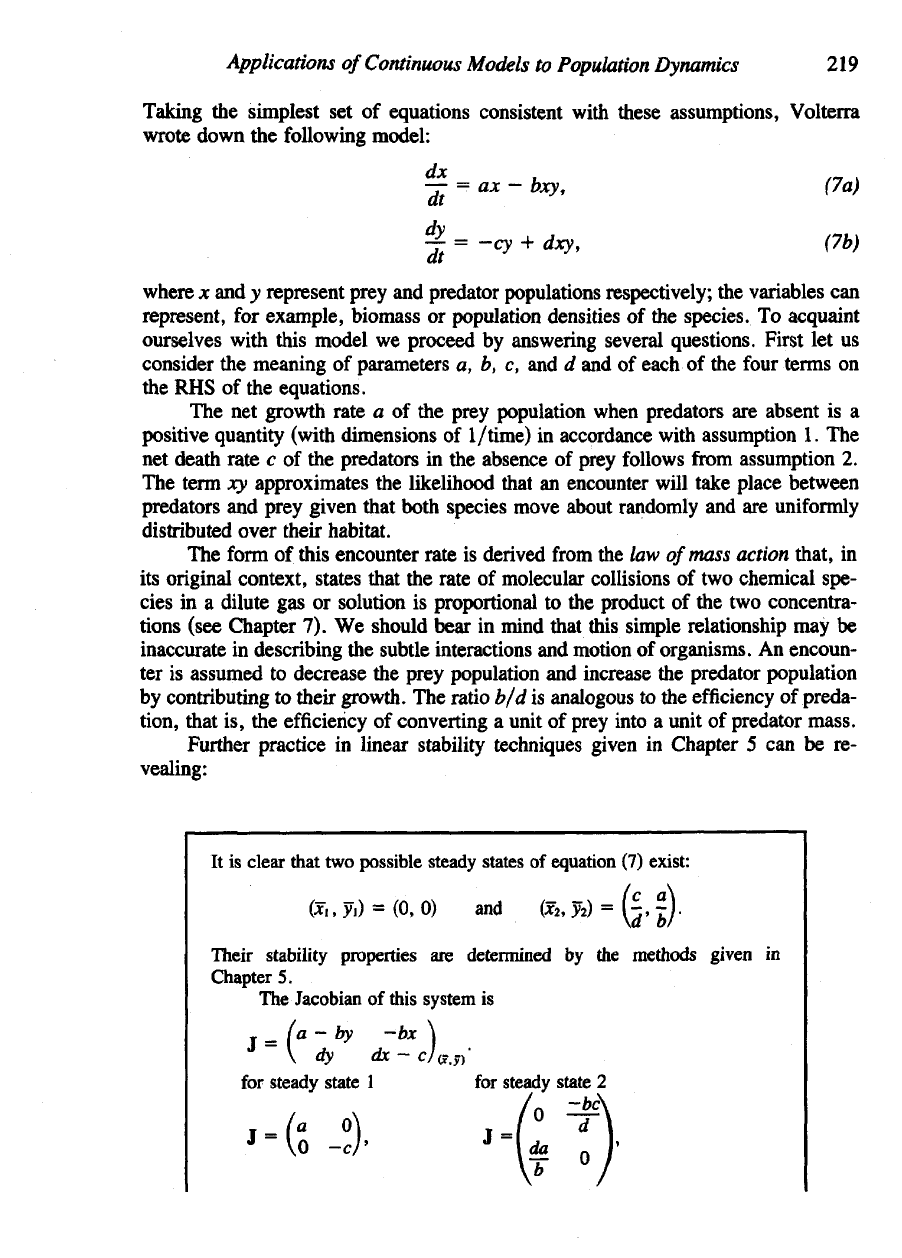
where
x and y
represent prey
and
predator populations respectively;
the
variables
can
represent,
for
example, biomass
or
population densities
of the
species.
To
acquaint
ourselves with this model
we
proceed
by
answering several questions. First
let us
consider
the
meaning
of
parameters
a, b, c, and d and of
each
of the
four
terms
on
the
RHS of the
equations.
The net
growth rate
a of the
prey population
when
predators
are
absent
is a
positive quantity (with dimensions
of
I/time)
in
accordance with assumption
1. The
net
death rate
c of the
predators
in the
absence
of
prey follows
from
assumption
2.
The
term
xy
approximates
the
likelihood
that
an
encounter will take place between
predators
and
prey given that both species move about randomly
and are
uniformly
distributed over their habitat.
The
form
of
this encounter rate
is
derived
from
the law
of
mass action that,
in
its
original context, states that
the
rate
of
molecular collisions
of two
chemical spe-
cies
in a
dilute
gas or
solution
is
proportional
to the
product
of the two
concentra-
tions (see Chapter
7). We
should bear
in
mind
that this simple relationship
may be
inaccurate
in
describing
the
subtle interactions
and
motion
of
organisms.
An
encoun-
ter is
assumed
to
decrease
the
prey population
and
increase
the
predator population
by
contributing
to
their growth.
The
ratio
b/d is
analogous
to the
efficiency
of
preda-
tion, that
is, the
efficiency
of
converting
a
unit
of
prey into
a
unit
of
predator mass.
Further
practice
in
linear stability techniques given
in
Chapter
5 can be re-
vealing:
Applications
of
Continuous
Models
to
Population
Dynamics
219
Taking
the
simplest
set of
equations consistent with these assumptions, Volterra
wrote down
the
following model:
It
is
clear
that
two
possible
steady states
of
equation
(7)
exist:
Their
stability
properties
are
determined
by the
methods given
in
Chapter
5.
The
Jacobian
of
this system
is
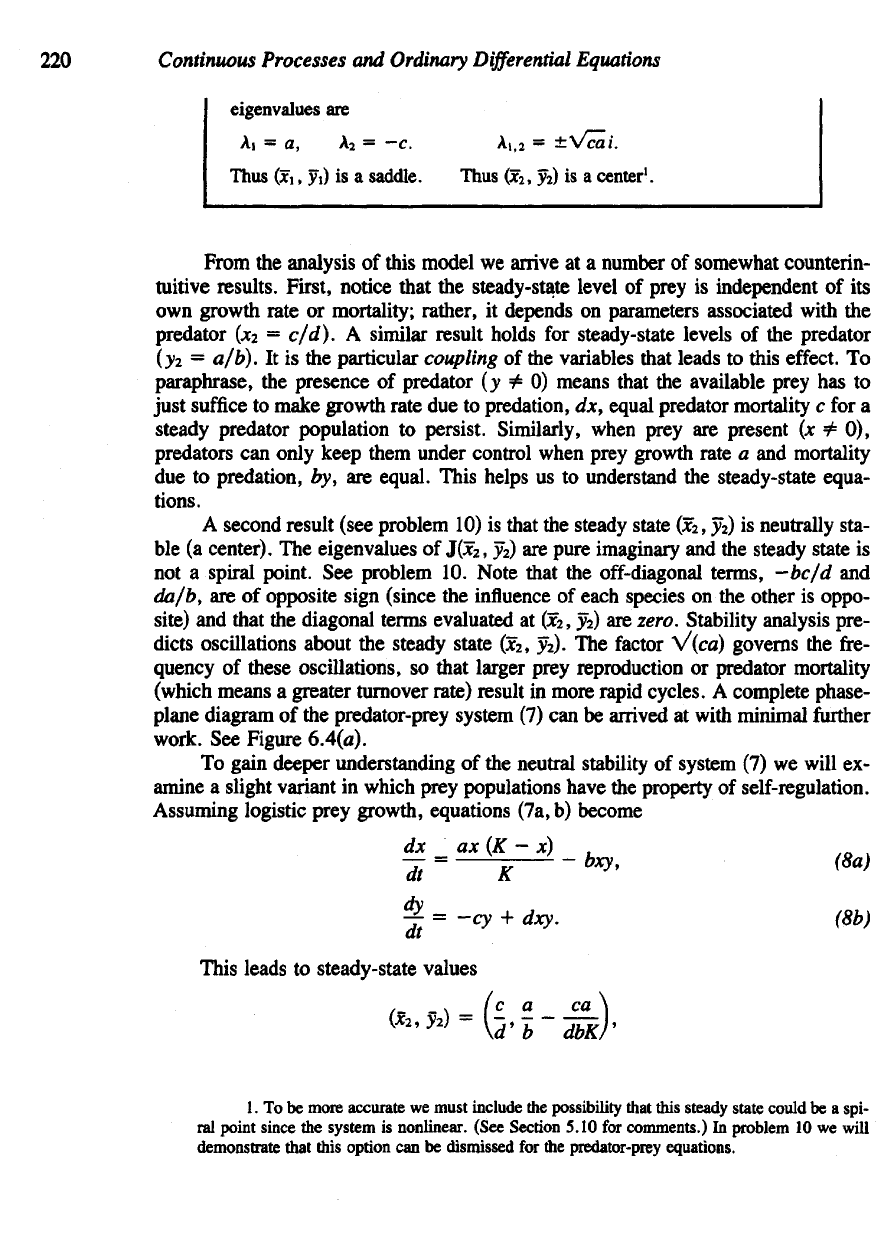
220
Continuous Processes
and
Ordinary
Differential
Equations
From
the
analysis
of
this model
we
arrive
at a
number
of
somewhat counterin-
tuitive results.
First,
notice that
the
steady-state level
of
prey
is
independent
of its
own
growth rate
or
mortality; rather,
it
depends
on
parameters associated with
the
predator
fa =
c/d).
A
similar result holds
for
steady-state levels
of the
predator
(y2
—
a/b).
It is the
particular
coupling
of the
variables that leads
to
this
effect.
To
paraphrase,
the
presence
of
predator
(y ± 0)
means that
the
available prey
has to
just
suffice
to
make growth rate
due to
predation,
dx,
equal predator mortality
c for a
steady predator population
to
persist.
Similarly,
when
prey
are
present
(x
¥=
0),
predators
can
only keep them under control when prey growth rate
a and
mortality
due
to
predation,
by, are
equal. This helps
us to
understand
the
steady-state equa-
tions.
A
second result (see problem
10) is
that
the
steady state
fa, 3^) is
neutrally sta-
ble (a
center).
The
eigenvalues
of
J(J
2
,5^)
are
pure imaginary
and the
steady state
is
not
a
spiral point.
See
problem
10.
Note that
the
off-diagonal terms, -bc/d
and
da/b,
are of
opposite sign (since
the
influence
of
each species
on the
other
is
oppo-
site)
and
that
the
diagonal terms evaluated
at
(xz,
ja) are
zero. Stability analysis pre-
dicts oscillations about
the
steady state (x
z
, Ja).
The
factor
V(c0) governs
the
fre-
quency
of
these oscillations,
so
that larger prey reproduction
or
predator mortality
(which
means
a
greater turnover rate) result
in
more rapid cycles.
A
complete phase-
plane diagram
of the
predator-prey system
(7) can be
arrived
at
with minimal
further
work.
See
Figure
6.4(a).
To
gain
deeper
understanding
of the
neutral stability
of
system
(7) we
will
ex-
amine
a
slight variant
in
which prey populations have
the
property
of
self-regulation.
Assuming
logistic prey growth, equations (7a,
b)
become
This leads
to
steady-state values
1.
To be
more accurate
we
must
include
the
possibility
that
this steady state could
be a
spi-
ral
point since
the
system
is
nonlinear. (See Section 5.10
for
comments.)
In
problem
10 we
will
demonstrate
that
this option
can be
dismissed
for the
predator-prey equations.
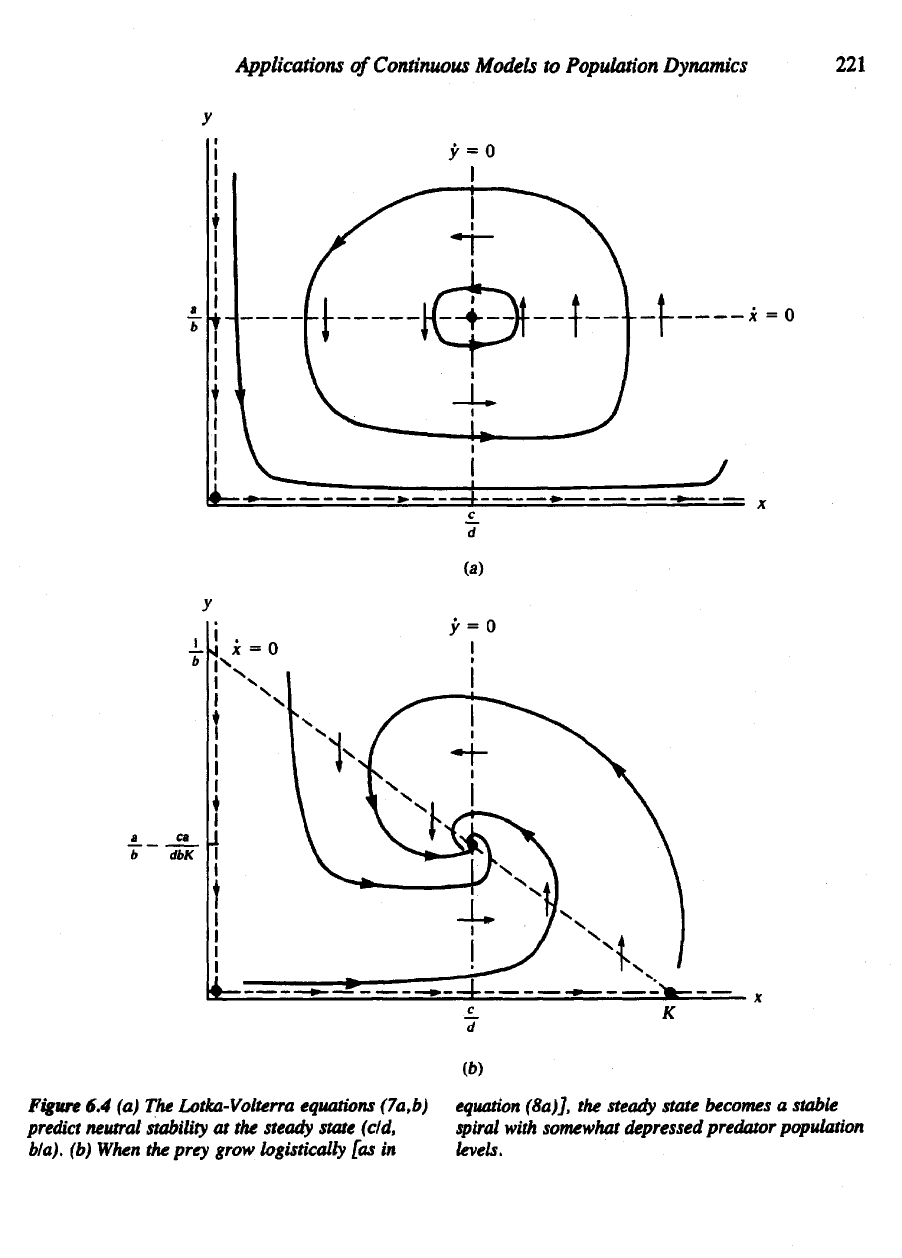
Applications
of
Continuous
Models
to
Population
Dynamics
221
Figure
6.4 (a) The
Lotka-Volterra equations (7a,b) equation (8a)],
the
steady state becomes
a
stable
predict
neutral stability
at the
steady state (eld,
spiral
with somewhat depressed predator population
b/a).
(b)
When
the
prey grow logistically
[as in
levels.
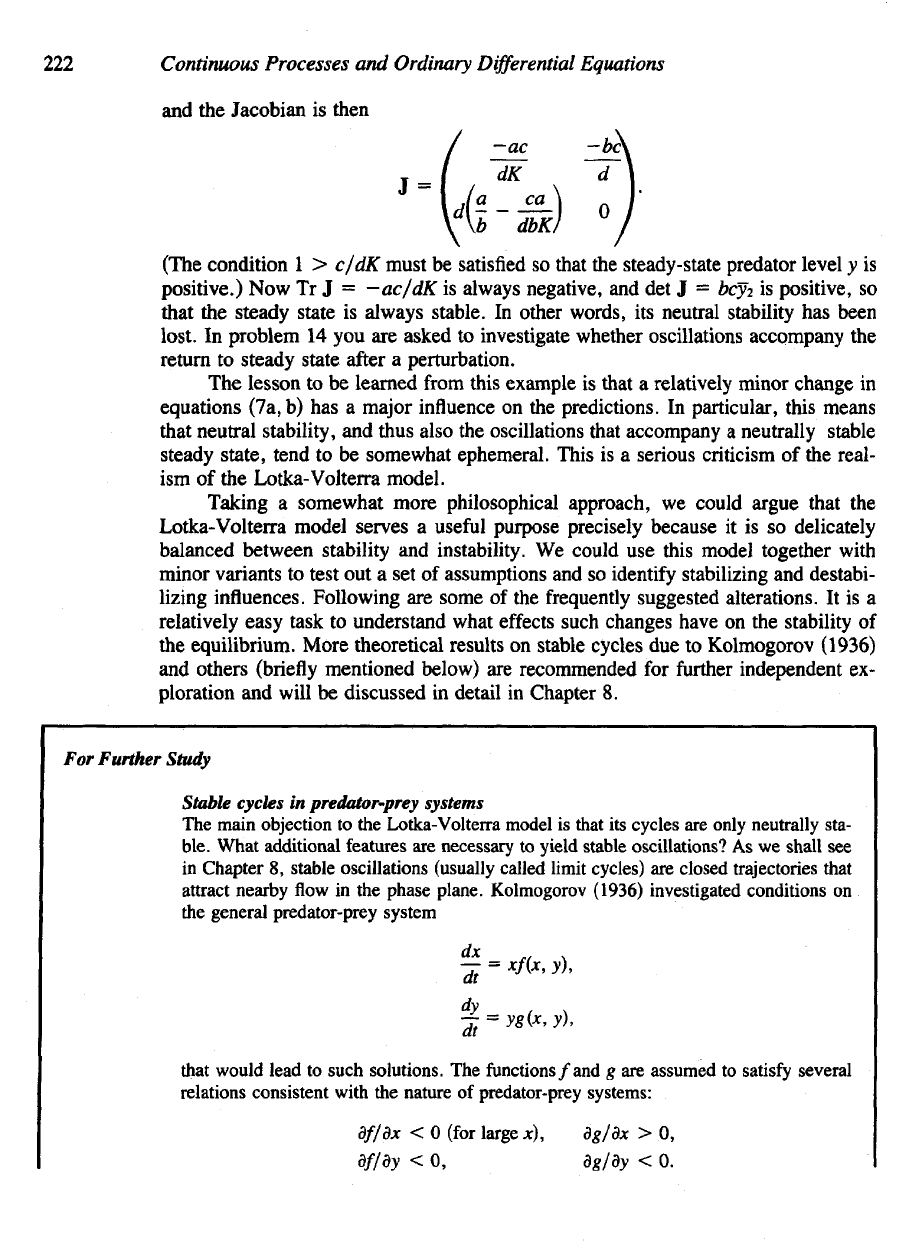
222
Continuous Processes
and
Ordinary
Differential
Equations
and
the
Jacobian
is
then
(The condition
1 >
c/dK must
be
satisfied
so
that
the
steady-state predator level
y is
positive.)
Now Tr J =
—ac/dK
is
always negative,
and det J =
bey2
is
positive,
so
that
the
steady state
is
always stable.
In
other words,
its
neutral stability
has
been
lost.
In
problem
14 you are
asked
to
investigate whether oscillations accompany
the
return
to
steady state
after
a
perturbation.
The
lesson
to be
learned
from
this example
is
that
a
relatively minor change
in
equations (7a,
b) has a
major
influence
on the
predictions.
In
particular, this means
that neutral stability,
and
thus
also
the
oscillations that accompany
a
neutrally stable
steady
state,
tend
to be
somewhat ephemeral. This
is a
serious criticism
of the
real-
ism
of the
Lotka-Volterra model.
Taking
a
somewhat more philosophical approach,
we
could argue that
the
Lotka-Volterra model serves
a
useful
purpose precisely because
it is so
delicately
balanced between stability
and
instability.
We
could
use
this model together
with
minor variants
to
test
out a set of
assumptions
and so
identify
stabilizing
and
destabi-
lizing influences. Following
are
some
of the
frequently
suggested alterations.
It is a
relatively easy task
to
understand what
effects
such changes have
on the
stability
of
the
equilibrium. More
theoretical
results
on
stable
cycles
due to
Kolmogorov (1936)
and
others
(briefly
mentioned below)
are
recommended
for
further
independent
ex-
ploration
and
will
be
discussed
in
detail
in
Chapter
8.
For
Further
Study
Stable
cycles
in
predator-prey systems
The
main objection
to the
Lotka-Volterra model
is
that
its
cycles
are
only neutrally sta-
ble. What
additional
features
are
necessary
to
yield
stable
oscillations?
As we
shall
see
in
Chapter
8,
stable oscillations
(usually
called limit cycles)
are
closed trajectories that
attract nearby
flow in the
phase plane. Kolmogorov (1936) investigated conditions
on
the
general predator-prey system
that
would lead
to
such solutions.
The
functions/and
g are
assumed
to
satisfy
several
relations consistent with
the
nature
of
predator-prey systems:
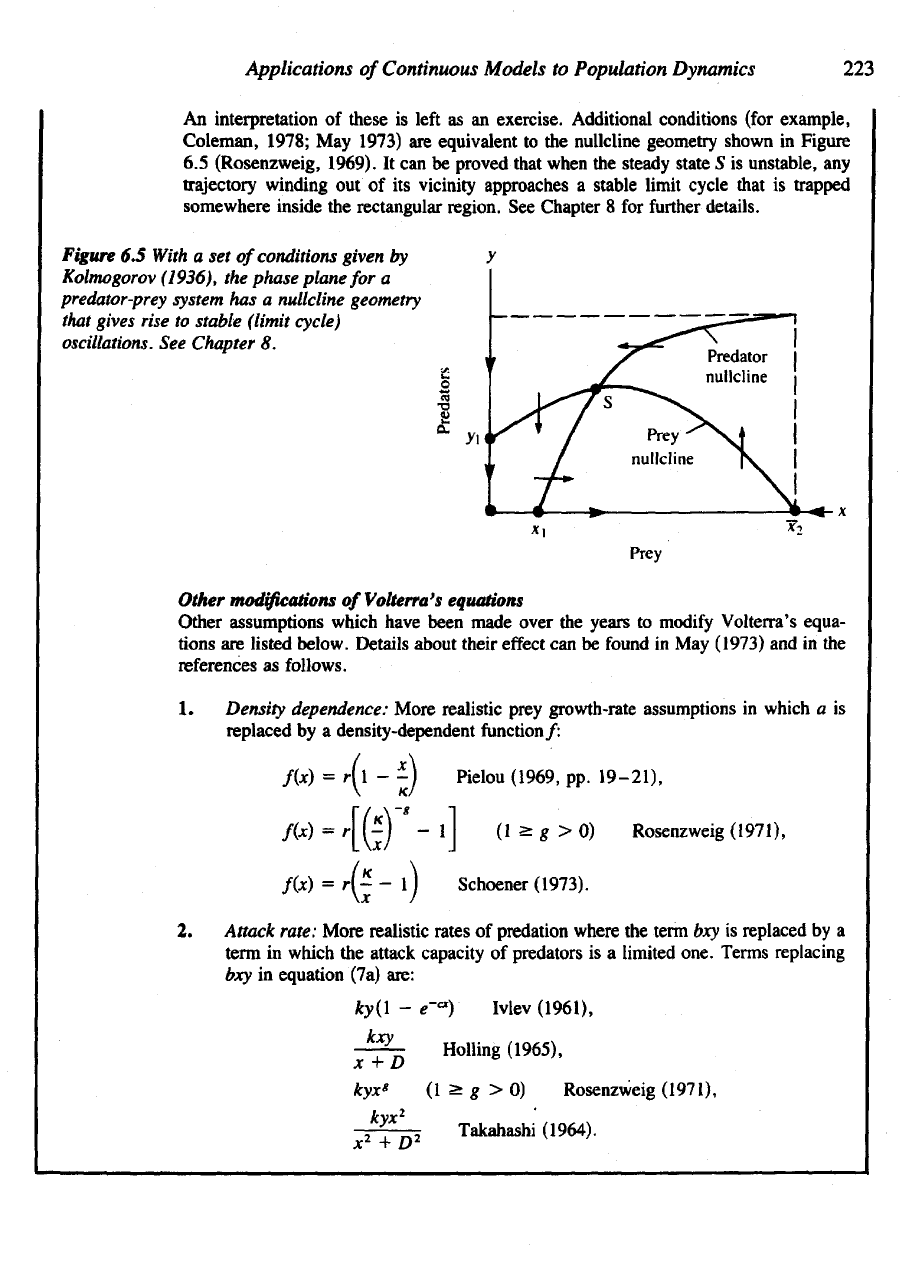
Applications
of
Continuous
Models
to
Population Dynamics
223
An
interpretation
of
these
is
left
as an
exercise. Additional conditions (for example,
Coleman, 1978;
May
1973)
are
equivalent
to the
nullcline geometry shown
in
Figure
6.5
(Rosenzweig,
1969).
It can be
proved that when
the
steady state
S is
unstable,
any
trajectory
winding
out of its
vicinity approaches
a
stable limit cycle
that
is
trapped
somewhere inside
the
rectangular region.
See
Chapter
8 for
further
details.
Figure
6.5
With
a set of
conditions given
by
Kolmogorov
(1936),
the
phase plane
for a
predator-prey
system
has a
nullcline
geometry
that
gives
rise
to
stable
(limit
cycle)
oscillations.
See
Chapter
8.
Other
modifications
of
Volterra's equations
Other
assumptions
which have been made over
the
years
to
modify
Volterra's equa-
tions
are
listed
below.
Details
about their
effect
can be
found
in May
(1973)
and in the
references
as
follows.
1.
Density
dependence:
More realistic prey growth-rate assumptions
in
which
a is
replaced
by a
density-dependent function/:
2.
Attack rate: More realistic rates
of
predation where
the
term
bxy is
replaced
by a
term
in
which
the
attack capacity
of
predators
is a
limited one. Terms replacing
bxy
in
equation (7a) are:
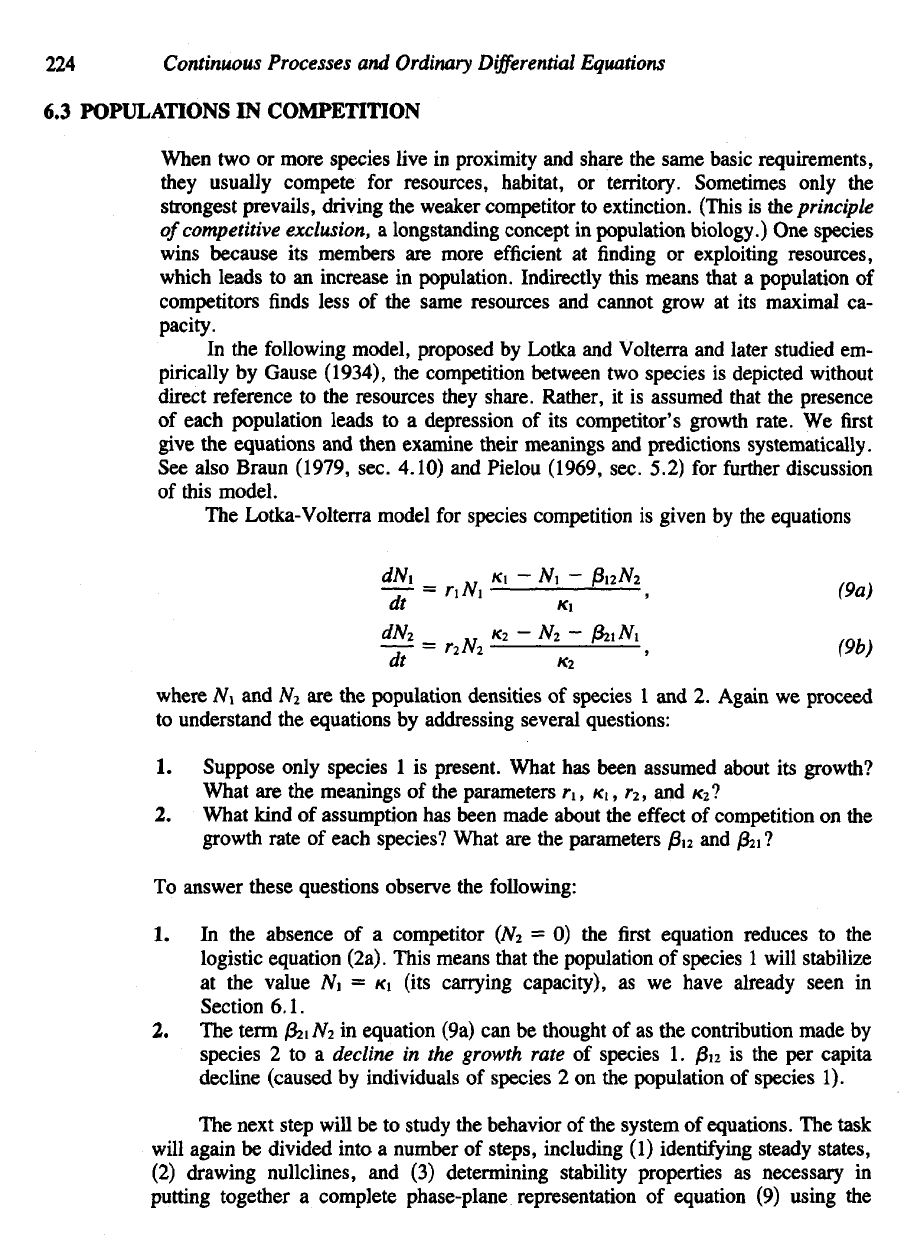
224
Continuous Processes
and
Ordinary
Differential
Equations
6.3
POPULATIONS
IN
COMPETITION
When
two or
more species live
in
proximity
and
share
the
same basic requirements,
they
usually compete
for
resources, habitat,
or
territory. Sometimes only
the
strongest prevails, driving
the
weaker competitor
to
extinction. (This
is the
principle
of
competitive
exclusion,
a
longstanding concept
in
population biology.)
One
species
wins
because
its
members
are
more
efficient
at finding or
exploiting resources,
which
leads
to an
increase
in
population. Indirectly this means that
a
population
of
competitors
finds
less
of the
same resources
and
cannot grow
at its
maximal
ca-
pacity.
In
the
following model, proposed
by
Lotka
and
Volterra
and
later studied
em-
pirically
by
Cause (1934),
the
competition between
two
species
is
depicted
without
direct reference
to the
resources they share. Rather,
it is
assumed that
the
presence
of
each population leads
to a
depression
of its
competitor's growth rate.
We first
give
the
equations
and
then examine their meanings
and
predictions systematically.
See
also
Braun
(1979, sec. 4.10)
and
Pielou (1969, sec. 5.2)
for
further
discussion
of
this
model.
The
Lotka-Volterra model
for
species competition
is
given
by the
equations
where
N\ and N^ are the
population
densities
of
species
1 and 2.
Again
we
proceed
to
understand
the
equations
by
addressing several questions:
1.
Suppose only species
1 is
present. What
has
been assumed about
its
growth?
What
are the
meanings
of the
parameters
r\,
KI
, r
2
, and K
2
?
2.
What kind
of
assumption
has
been made about
the
effect
of
competition
on the
growth
rate
of
each species? What
are the
parameters
j3i
2
and
j&i
?
To
answer these questions observe
the
following:
1. In the
absence
of a
competitor
(N
2
= 0) the first
equation reduces
to the
logistic
equation (2a). This means that
the
population
of
species
1
will stabilize
at
the
value
N\ = K\
(its carrying capacity),
as we
have already seen
in
Section 6.1.
2. The
term
fa N
2
in
equation (9a)
can be
thought
of as the
contribution made
by
species
2 to a
decline
in the
growth rate
of
species
1. fin is the per
capita
decline (caused
by
individuals
of
species
2 on the
population
of
species
1).
The
next step will
be to
study
the
behavior
of the
system
of
equations.
The
task
will
again
be
divided into
a
number
of
steps, including
(1)
identifying steady states,
(2)
drawing nullclines,
and (3)
determining stability properties
as
necessary
in
putting
together
a
complete phase-plane representation
of
equation
(9)
using
the
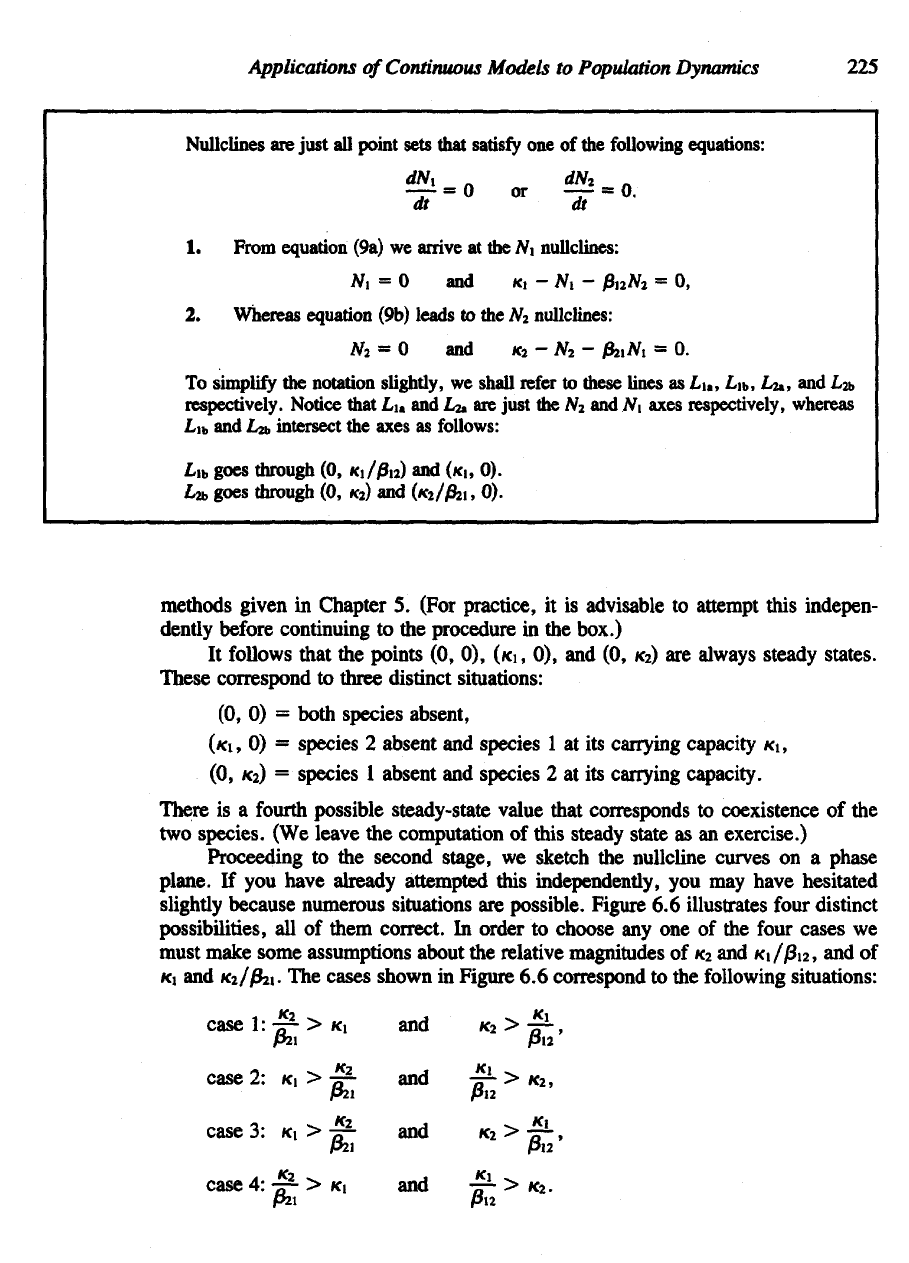
Applications
of
Continuous
Models
to
Population
Dynamics
225
Nullclines
are
just
all
point sets
that
satisfy
one of the
following
equations:
1.
From equation (9a)
we
arrive
at the
NI
nullclines:
2.
Whereas
eauation
(9b)
leads
to the
N-,
nullclines:
To
simplify
the
notation slightly,
we
shall
refer
to
these lines
as L
u
,
LU,,
L&, and L
2b
respectively. Notice
that
L
u
and L^ are
just
the N
2
and N\
axes respectively,
whereas
Lib
and La,
intersect
the
axes
as
follows:
Li
b
goes
through
(0,
Ki//3i
2
)
and
(KI,
0).
Lab
goes
through
(0, K
2
) and
(^//fci,
0).
methods
given
in
Chapter
5.
(For practice,
it is
advisable
to
attempt this indepen-
dently
before continuing
to the
procedure
in the
box.)
It
follows that
the
points
(0, 0),
(KI,
0), and (0,
Ka)
are
always steady states.
These correspond
to
three distinct situations:
(0,
0) =
both
species
absent,
(KI,
0) =
species
2
absent
and
species
1 at its
carrying capacity
KI,
(0, K
2
) =
species
1
absent
and
species
2 at its
carrying capacity.
There
is a
fourth
possible
steady-state value that corresponds
to
coexistence
of the
two
species.
(We
leave
the
computation
of
this steady state
as an
exercise.)
Proceeding
to the
second stage,
we
sketch
the
nullcline curves
on a
phase
plane.
If you
have already attempted this independently,
you may
have hesitated
slightly
because numerous situations
are
possible. Figure
6.6
illustrates
four
distinct
possibilities,
all of
them
correct.
In
order
to
choose
any one of the
four
cases
we
must
make some assumptions about
the
relative magnitudes
of
KZ
and
K\/(3n,
and of
KI
and
Ki/jSii-
The
cases shown
in
Figure
6.6
correspond
to the
following situations:
